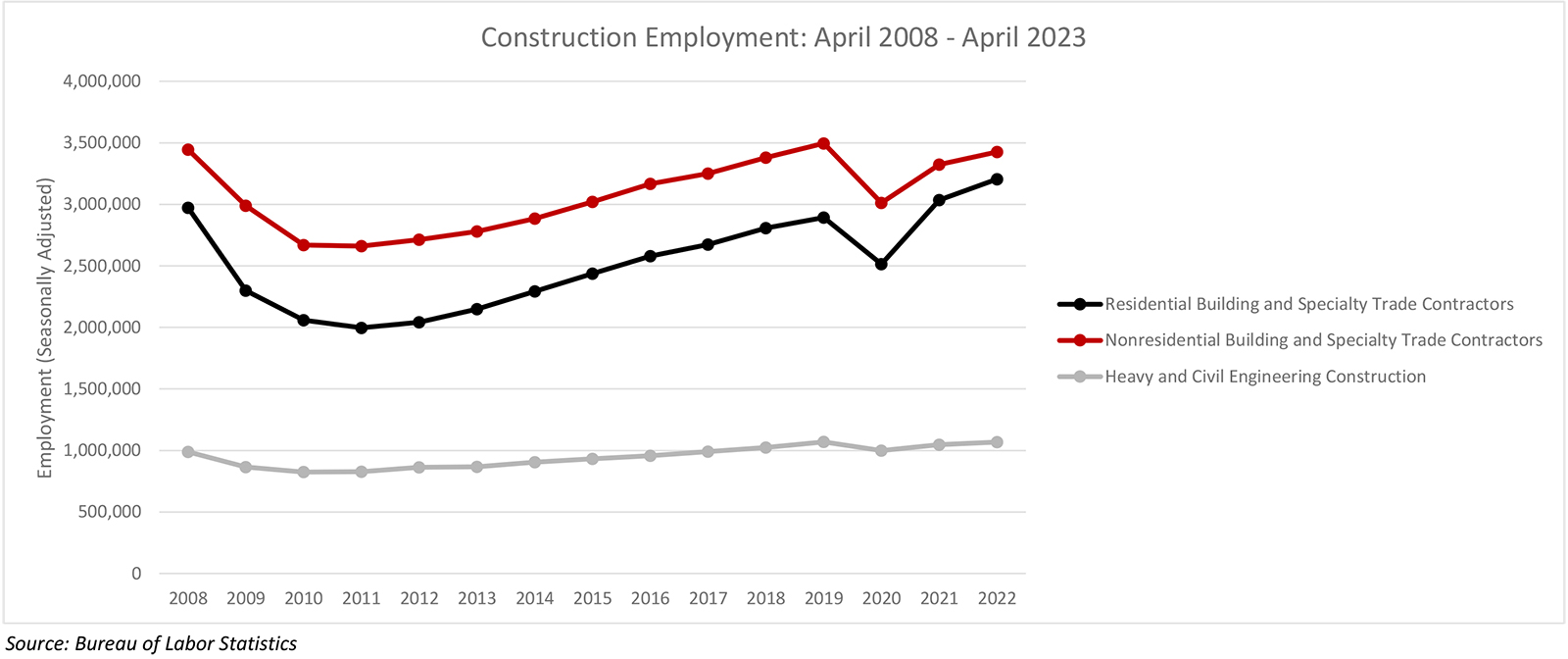
According to data released today by the US Bureau of Labor Statistics, the national construction industry gained 15,000 jobs on net in April.
Key Takeaways
- The construction industry gained 15,000 jobs on net in April.
- Nonresidential construction employment increased by 800 positions on net, with gains in the Nonresidential Specialty Trade Contractors category offsetting declines in the other two subcategories.
- "Despite adding just 800 net jobs in April, nonresidential construction payrolls have expanded at a faster pace than the broader economy over the past year. Job creation continues to exceed expectations, and April saw the unemployment rate return to the lowest level since 1969. Put simply, the demand for workers remains significantly above the supply."

Press Release from Associated Builders and Contractors, Inc (ABC)
Construction Adds 15,000 Jobs in April, Says ABC
WASHINGTON, May 5—The construction industry added 15,000 jobs on net in April, according to an Associated Builders and Contractors analysis of data released today by the U.S. Bureau of Labor Statistics. On a year-over-year basis, industry employment expanded by 205,000 jobs, an increase of 2.7%.
Nonresidential construction employment rose by 800 positions on net, with growth in only one of the three subcategories. Nonresidential specialty trade contractors added 10,700 positions. The number of heavy and civil engineering jobs decreased by 8,100, while nonresidential building lost 1,800 jobs on net.
The construction unemployment rate dropped to 4.1% in April. Unemployment across all industries decreased to 3.4%.
“Despite adding just 800 net jobs in April, nonresidential construction payrolls have expanded at a faster pace than the broader economy over the past year,” said ABC Chief Economist Anirban Basu. “Job creation continues to exceed expectations, and April saw the unemployment rate return to the lowest level since 1969. Put simply, the demand for workers remains significantly above the supply. This is especially true for contractors, a majority of whom intend to increase their staffing levels over the next six months, according to ABC’s Construction Confidence Index."
“Beyond the labor market, signs of a softening economy are apparent,” said Basu. “This week, the Federal Reserve raised interest rates again. Meanwhile, regional banks remain under pressure. While it is conceivable that the end of the banking crisis is near, credit conditions are likely to tighten further during the months ahead. This is especially problematic for commercial real estate, which faces a debt maturity wall over the next four years. Developers and other private purchasers of construction services are likely to suffer difficulty refinancing debt going forward, dampening demand for new construction.”
Press Release from Associated General Contractors of America (AGC)
Most of the Construction Gains Occurred in the Residential Construction Sector While Firms Now Pay Workers 19 Percent More Compared to the Average Job as they Struggle to Recruit New People
The construction sector added 15,000 jobs in April while the sector’s unemployment rate fell to a record low for the month and the number of unfilled construction positions is close to a monthly high, according to an analysis of new government data the Associated General Contractors of America released today. Association officials said the industry likely would have added even more positions if contractors could find more qualified workers.
“Contractors can’t find, reach, hire and train workers fast enough to keep pace with demand,” said Stephen E. Sandherr, the association’s chief executive officer. “The pool of qualified, available labor is the smallest the industry has ever seen for the month of April.”
Construction employment in April totaled 7,903,000, seasonally adjusted, an addition of 15,000 or 0.2 percent from the month prior. Nonresidential construction firms—nonresidential building and specialty trade contractors along with heavy and civil engineering construction firms—added only 800 employees in April. Meanwhile, employment at residential building and specialty trade contractors grew by 14,200 or 0.4 percent.
The unemployment rate among jobseekers with construction experienced declined from 4.6 percent in April 2022 to 4.1 percent, the lowest April rate in the 23-year history of the data. A separate government report released earlier this week reported that job openings in construction at the end of March totaled 355,000, just shy of the all-time high for March of 359,000.
Average hourly earnings for production and nonsupervisory employees in construction—covering most onsite craft workers as well as many office workers—jumped by 6.7 percent over the year to $33.94 per hour. Construction firms in April provided a wage “premium” of nearly 19 percent compared to the average hourly earnings for all private-sector production employees.
Association officials noted that the industry is struggling to recruit workers at a time when the federal government spends five dollars to encourage students to go to college and worker in service sector professions for every dollar it invests in career and technical education. They urged public officials to boost funding for construction education and training, and to explore short-term measures, like immigration reform, to address severe labor shortages.
“Federal officials are making massive investments in infrastructure even while their funding policies actively discourage most future workers from considering careers in construction,” Sandherr said. “They don’t seem to want our citizens to work in construction even while they block people from other countries from lawfully entering the profession.”













